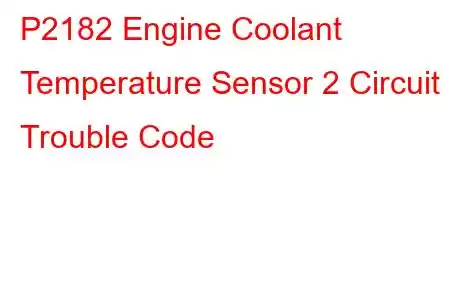P2182 Engine Coolant Temperature Sensor 2 Circuit Malfunction
OBD-II Trouble Code Technical Description
Engine Coolant Temperature Sensor 2 Circuit Malfunction
What does that mean?
This diagnostic trouble code (DTC) is considered generic because it applies to all 1996-newer OBD-II equipped vehicles (e.g. Vauxhall, VW, Ford, Dodge, etc.). Specific troubleshooting and repair steps may vary slightly depending on make/model.
The ECT (Engine coolant temperature) sensor is basically a thermistor that changes resistance with temperature. Usually a two wire sensor, a 5 volt reference from PCM (Powertrain Control Module) and ground signal to PCM. This is different from a temperature SENDER (which usually operates the dash temperature gauge and operates in a similar way as the SENSOR, only it's a different circuit than what a P2182 is referring to).
As the temperature of the coolant changes, the resistance changes on the ground signal to the PCM. When the engine is cold, the resistance is high. When the engine is warm, the resistance is low. If the PCM detects a voltage condition that seems abnormally low or high, P2182 will set.
An example of an Engine Coolant Temperature ECT sensor
Note: This DTC is basically identical to P0115, however the difference with this code is that this refers to the #2 ECT circuit. So vehicles exhibiting this code means they have two ECT sensors. Be sure you are diagnosing the correct sensor circuit.
Symptoms
Symptoms of a P2182 DTC code can vary from nothing other than the "check engine" light illumination, to one or more of the following:
MIL (Malfunction Indicator Lamp) illumination will always occur Vehicle may be hard to start May blow a lot of black smoke and run extremely rich Engine may want to die or backfire in tailpipe Engine may run lean and increased Nox emissions may be apparent (Requires gas analyzer) Cooling fans may run all the time when they shouldn't be, or not at all when they should beCauses
Usually the cause can be traced to a bad ECT sensor, however that doesn't preclude the following:
Wiring or connector damaged at #2 ECT sensor Open or short in reference or signal circuit Open or short in ECT #2 signal circuit Bad PCMPossible Solutions
First, visually check the #2 ECT sensor for damage to wiring or connector and repair as necessary. Then, if you have access to a scanner, determine what the temperature of the engine is. (If you don't have access to a scan tool, using the dash temperature gauge may not be an effective way to determine coolant temperature. This is because the P2182 code is referring to the #2 ECT SENSOR, and the dash gauge is operated by, usually a one-wire SENDER. Basically a different sensor that the code doesn't refer to.)
2. If the engine temperature is abnormally high, around 280 deg. F, that's abnormal. Unplug the sensor on the engine and see if the signal drops to, say, negative 50 deg. F. If it does, then it's a good bet the sensor is bad, internally shorted, causing a low resistance signal to be sent to the PCM. However if you want to be sure it's the sensor and not the wiring, there's a couple tests you can do. With the ECT sensor unplugged, check that you have 5 volts on the reference circuit with KOEO (Key on engine off). Also you can check the resistance of the sensor to ground using an Ohm meter. The resistance of a normal sensor to ground will vary a little depending on the vehicle, but basically, if the temp of the engine is around 200 deg. F., the resistance will be about 200 Ohms. If the temperature is about 0 def. F., the resistance will be over 10,000 Ohms. With this test you should be able to tell if the resistance of the sensor matches the temperature of the engine. If it's not accurate according to your engine's temperature, then you probably have a bad sensor.
3. N
Read: 27


